
Arab Musical InstrumentsFrom Fairouz; Legend and Legacy |
|
|
In every Arab country, one hear the same distinctive sounds; whether instrumental or vocal, the melodies are remarkably similar in emotive power, tonal range, and rhythmic drive. Although the practiced ear can recognize variations of musical style, as it can the dialects of language which distinguish the spoken word from country to country, the sounds remain unmistakably those of the music of one people. The historical origins of this music, however, are extremely heterogeneous. Early Arab musicians borrowed copiously from the Egyptians, Assyrians, and Sumerians. Many of the instruments now used are direct descen dents of those depicted in the wall paintings and carvings of these past civilizations. The distinctive quality of Arab music owes a great deal to the type of instruments employed. As ancient and traditional as the music itself, the present forms of these instruments evolved primarily in the eighth through tenth centuries, during that creative zenith of classical Islamic civilization known as the Golden Age.
|
|
|
The English word lute, which derives from the Spanish laud, originally
came from the Arabic al-'ud, literally meaning 'branch of wood.'
Between the eighth and tenth cen turies, the 'ud had only four
strings; a fifth was added by Zitiab, the famous Andalusian performer,
and a sixth later on in the fifteenth century. Shaped like half a pear
with a short fretted neck, the 'ud is a six courses of two-strings
instrument played with a plectrum - often a trimmed eagle's
feather - producing a deep and mellow sound Virtuosos across the
Middle East refer to it as 'the King of all instruments.'
|
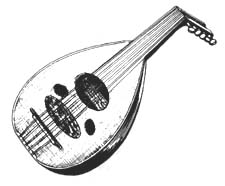
|
|
The tablah is a small hand-drum also known as the durbakke. One of the
most commonly played of the percussion instruments, the tablah is a
membranophone of goat or fish skin stretched over a vase-shaped drum
with a wide neck. Usually made of earthenware or metal, it is placed
either under the left arm or between the legs and struck in the middle
for the strong beats and on the edge for the sharp in-between beats.
|
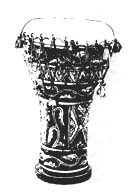
|
|
The qanun is a descendent of the old Egyptian harp and has played an
integral part in Arab music since the tenth century. A kind of
dulcimer, its Arabic name means 'rule' or 'law.' The qanun was
introduced to Europe by the 12th Century, becoming known during the
14th to the 16th Century as a psaltery or zither.
The form of the qanun consists of a trapezoid-shaped flat board over
which 81 strings are stretched in groups of three with 24 treble
chords consisting of three chords to each note. The instrument is
placed flat on the knees or table of the musician; the strings are
plucked with the finger or with two plectra, one plectrum attached to
the forefinger of each hand.
More than any other instrument in Arab music, the qanun is suitable for
the display of virtuosity, the execution of fioriture and rapid
scales. Interestingly, this traditional Arabic instrument, absent from the Rahbani orchestra, has been replaced by the less complex piano, itself an outgrowth of the harpsichord, an instrument which exchanged the zither's plectra with hammers.
|
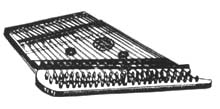
|
|
The word nay from Persian is used to describe a single reed pipe of
the simplest design whose origins go back to the Sumerian
civilization. Nay is the generic Arabic name for simple open-ended reed instruments whi ch usually have 6 holes in the front for the fingers to play and 1 hole underneath for the thumb. Fine, mellow tones are brought forth by blowing gently over the orifice of the tube while manipulating the fingers and thumbs; by blowing with more or less force, sounds are produced an octave higher or lower, and tunes in different scales can be played by utilizing nays of various lengths. Although very simple, the nay is extraordinarily versatile. Its poetical timbre makes it especially suitab le for melancholy effects expressing both joy and yearning.
|

|
|
The mijwiz, which literally means 'dual' in Arabic, is a type of
double reed clarinet popular in Syria, Lebanon and Palestine. In North
Africa its equivalent is known as the maqrum. It is played by
breathing gently through a circular aperture the end and by
manipulating the fingers over the holes down the front of the tube, in
order to produce specific sounds. In the hands of a good performer, the sounds produced by the mijwiz may very well reflect the musical dialogue between two moods. Similar to the mijwiz is the minjayrah, an open-ended small reed flute played in the same manner, popular among the mo tain villagers of Lebanon.
|
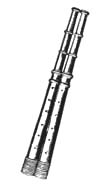
|
|
The word buzuq comes from the Turkish and occurs in 'bashi-buzuq,' the
name given to the Ottoman troops, literally meaning 'burnt head' or
'uprooted.' The buzuq, which is an essential instrument in the Rahbani
repertoire, is a hybrid instrument that is not classified among the
classical instruments of Arab music nor among those of Turkish
music. However, this instrument may be looked upon as a larger and
deeper-toned relative of the Turkish saz, to which it could be
compared in the same way as the viola to the violin in Western
music. Before the Rahbanis popularized the use of this instrument, the
buzuq had been associated with the gypsy music of Lebanon and Syria. A long-necked fretted string instrument, the buzuq is furnished with 2 metal strings which are played with a plectrum, offering a metallic yet Iyrical resonance.
|
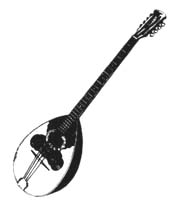
|
|
Also known as the rikk, the daff is the Arabic name for the popular
instrument corresponding to the English tambourine. It consists of a
round frame, covered on one side with goat or fish skin. Pairs of
metal discs are set into the frame to produce the jingle when struck
by the hand. The sounds of this percuss ion instrument set the rhythm
of much Arab music, particularly in the performances of classical
pieces.
|

|

al@mashriq 960812